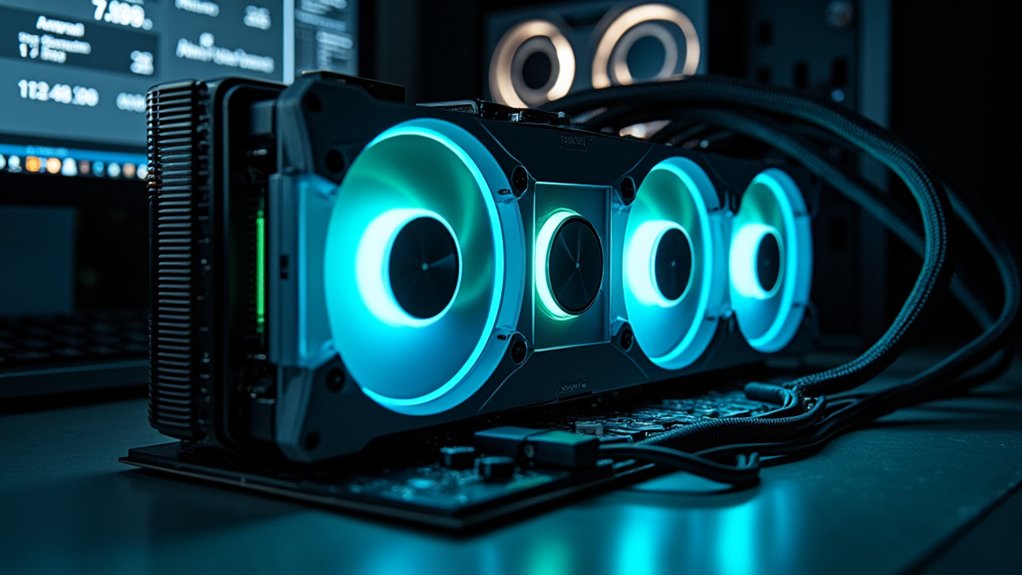Mining cryptocurrency profitably requires strategic hardware selection between ASICs for Bitcoin and Litecoin ($3,000-$15,000), GPUs for Ethereum Classic and Zcash ($1,500-$10,000), or CPUs for Monero ($500-$1,500). Successful miners minimize electricity costs (averaging $0.13/kWh), join mining pools to guarantee consistent returns despite increasing network difficulty, and diversify across multiple coins to mitigate risk. Balancing initial investment against operational expenses, including energy consumption and pool fees (1-3%), determines long-term viability in this competitive landscape. Further analysis reveals essential optimization techniques for sustainable mining operations.

Maneuvering the complex and rapidly evolving landscape of cryptocurrency mining requires a strategic approach to hardware selection, energy management, and cryptocurrency diversification. Miners must evaluate their investment capacity against potential returns, considering that ASICs, which dominate Bitcoin and Litecoin mining, represent significant capital outlays of $3,000-$15,000 per unit but deliver superior hash rates and energy efficiency ratios.
Success in crypto mining hinges on strategic hardware choices, efficient energy management, and appropriate diversification across digital assets.
These specialized machines, while costly, provide competitive advantages in high-difficulty networks where mining rewards have grown increasingly difficult to secure amid institutional competition.
For individuals with moderate investment capacities, GPU mining presents a viable alternative at $1,500-$10,000, particularly for cryptocurrencies like Ethereum Classic and Zcash that remain resistant to complete ASIC dominance. Building a custom mining rig with multiple GPUs allows for better airflow and improved mining performance compared to traditional computer setups. These graphics processing units strike an economic balance between acquisition costs and operational expenses, though their energy consumption per hash exceeds that of purpose-built ASICs.
Miners operating with limited capital may consider CPU mining for coins specifically designed to resist ASIC implementation, such as Monero and Vertcoin, requiring initial investments of only $500-$1,500, albeit with correspondingly lower hash rates and profit potential.
Electricity costs remain the critical operational variable in mining economics, with the standard $0.13/kWh potentially consuming significant portions of gross mining revenue. Successful operations typically require access to electricity rates below national averages, especially since block rewards diminish over time through halving events and increasing network difficulty. The most recent halving in April 2024 reduced Bitcoin's reward to 3.125 BTC per block, making efficient energy use even more crucial for profitability.
Bitcoin's current 3.125 BTC block reward, for instance, must be weighed against the growing computational power required to secure even fractional shares of this reward through mining pool participation. Mining profitability is further influenced by network difficulty levels that adjust dynamically as more miners join the ecosystem.
Mining pools, which distribute rewards proportionally based on contributed hash power, have become essential infrastructure for individual miners seeking consistent returns rather than the high-variance outcomes associated with solo mining.
These collectives typically charge fees of 1-3% but dramatically reduce the time between reward distributions. Miners selecting pools must evaluate payment methodologies, including guaranteed pay-per-share models versus proportional reward systems, considering their risk tolerance and liquidity requirements within the volatile cryptocurrency market environment.
Frequently Asked Questions
Is Crypto Mining Legal in All Countries?
Cryptocurrency mining legality varies considerably worldwide, with distinct regulatory approaches across three categories.
While countries like the United States, Canada, and Australia permit mining with varying restrictions, nations including China, Algeria, and Iraq have implemented outright bans.
Mixed jurisdictions, including Sweden, Kazakhstan, and India, maintain legal frameworks with considerable constraints, including excessive energy taxation, temporal restrictions during power surpluses, or hefty income taxes on mining profits.
How Much Electricity Does Mining Typically Consume?
Crypto mining consumes substantial electricity, with Bitcoin operations alone requiring 91-150 terawatt-hours annually, surpassing Finland's total usage.
Individual Bitcoin transactions demand approximately 851 kWh, equivalent to a month's household consumption in the United States.
ASIC mining devices typically use around 155,000 kWh per Bitcoin mined, with additional energy required for cooling systems.
Can Mining Damage My Computer Hardware?
Cryptocurrency mining poses significant risks to computer hardware through thermal stress, electrical strain, and accelerated component degradation.
The continuous high-load operation subjects GPUs to sustained temperatures that deteriorate performance, while power fluctuations can damage circuitry over time. Silicon degradation occurs from electrical stress, particularly with overclocking, while cooling systems and thermal paste face premature failure.
Additionally, dust accumulation exacerbates overheating issues, and inadequate power management can lead to catastrophic component failure or potential fire hazards.
When Is the Best Time to Sell Mined Cryptocurrency?
The ideal timing for cryptocurrency liquidation varies based on multiple factors, including market conditions and individual financial objectives.
Analysts generally recommend selling during price peaks following significant bull runs, when profit targets are reached, or when fundamental project indicators deteriorate.
Strategic approaches include implementing dollar-cost averaging to reduce timing risks, maintaining partial holdings for future appreciation, and selling incrementally during high trading volume periods to maximize liquidity without substantially impacting market price.
How Do Mining Pools Distribute Earnings Among Participants?
Mining pools distribute earnings through several mechanisms, including PPS, which provides fixed rewards per share regardless of block discovery; Proportional, which allocates rewards based on contribution after successful blocks; PPLNS, which considers a miner's recent contributions to encourage loyalty; and FPPS, which incorporates transaction fees alongside block rewards.
Distribution fundamentally depends on computational contribution, with factors like rejected shares, submission timeliness, and pool efficiency ultimately determining each participant's share of the collective earnings.









